The Quarterly '97January - MarchFrom SOLIDERE |
 |
The Quarterly '97January - MarchFrom SOLIDERE |
 |
| The reconstruction of the Souks of Beirut, SOLIDERE'S most significant Phase One development project, was launched this year, marking an important milestone in the development of the Central District. Scheduled for completion in 1999, the Souks of Beirut combine traditional architecture in a modern environment offering commercial and entertainment centers and will provide an important impetus to the reactivation of the heart of the Lebanese capital. |
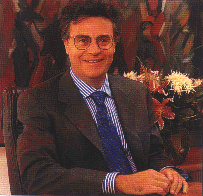
Dear Shareholders,
SOLIDERE'S excellent results for fiscal year 1996 reaffirm the relevance of the strategy pursued by the Company in the development and reconstruction of the Beirut Central District.
The financial results at year-end show a net profit of US$58.9 million representing an 82% increase over 1995. This remarkable achievement is the result of the enthusiasm and confidence displayed by investors in the BCD project from the start of works.
Together with the success of the GDR offering, the results confirm the financial strength of the company, as evidenced by an increase in its assets from US$1,703 million to US$1,777 million, and an increase in cash and short- term receivables from US$366 million at end of 1995 to US$427 million at end 1996, of which US$329 million represent cash balance.
The strategy that generated these extremely satisfying results is essentially comprised of three components:
-the rapid achievement of infrastructure works in the traditional BCD and the vacation of SOLIDERE properties;
-generating development projects through a wide and diversified range of operators;
-establishing a strong rental market in BCD.
The swift progress of infrastructure works in the traditional BCD has become an extremely tangible reality on the ground, an important part of the historic core was equipped with new roads and utilities, while works advanced just as rapidly in other sectors. Landfill treatment proceeded at an accelerated rate, while contracts were finalized in 1996 for the execution of the marine works and the power substation. This action, which was implemented parallel to the vacation of properties, ensured the feasibility of all developers' and investors' projects in the BCD.
Since its inception in 1994, SOLIDERE has been fully aware that the success of the project relies greatly on the involvement of the maximum number and variety of participants. This strategy has been received with great enthusiasm, as more than 200 investors and developers are currently actively engaged in the BCD, with investments up to the year 2000 estimated at US$1.5 billion.
The year 1996 witnessed the first concrete results of the Company's policy aiming at establishing a strong rental market in the BCD, which in turn will ensure the stability and flexibility of the whole real estate market. To that end, works began in 1996 on a major office development destined for occupation by UN agencies in September 1997. A large number of preserved buildings are being restored and rehabilitated, to be leased during this year. In addition, an agreement was reached with the government to build and lease several office buildings to a number of government agencies and administrations.
The relevance of the Company's strategy is further corroborated by large financial institutions who published several research reports on SOLIDERE in 1996. All reports conclude that the SOLIDERE shares are currently trading at a significant discount to the true value of the shares, validate company strategy, and testify to the quality of its management. I proudly conclude this message by congratulating all those involved in the reconstruction of the BCD, in particular the Company staff. Their joint effort will help revitalize the heart of the Lebanese capital, thus confirming and consolidating international investors' confidence.
Nasser Chammaa
Chairman and General Manager
Solidere announced a net profit of US$58.9 million for 1996, representing an 82 % increase over 1995, according to the year-end financial statement of the Company. Total revenue for 1996 was US$70.9 million, representing an increase of 63% over 1995. The financial results reflect the success of the company in achieving its Business Plan objectives.
Scheduled BCD operations for the year 1997 include the following:
1-The continuation of the infrastructure works in the traditional BCD, to be concluded by 1998;
2-Works will start on the sea defense lines and the BCD power substation, after contracts for both projects were finalized in 1996;
3-Completion of the ESCWA headquarters on Riad el Solh to be delivered at the end of 1997;
4-Completion of the restoration works on a majority of retained buildings;
5-Start of construction of new projects by SOLIDERE that are part of the Business plan 1996-1999. Those include the Souks, the Saifi apartment buildings, new government offices, in addition to other real estate projects by independent developers;
6-Launching of developments targeted to the rental and property management markets, as basic objectives of the Company's Business Plan.
-Implementation of the marketing strategy adopted in 1996, and which has proven its viability. To date, 54 of the 56 promises of sale have been finalized.
SOLIDERE has put in place a working plan for its Phase One 1994-1999 that targets a comprehensive reactivation of the city center and the establishment of a critical mass by 1999 through the development of 1.25 million square meters of floor space.
SOLIDERE has adopted a system for the archiving of video footage of all work in progress in the BCD collected since 1994, date of the establishment of the company and the launching of its activities. A computer software program known as D client was specially developed to record the information electronically and to provide fast and easy access to all the material.
The system also provides easy access to maps and pictures of all land parcels, buildings, streets, squares, city landmarks, archeological sites, as well as a record of visits by dignitaries and delegations. The archive also maintains a detailed record of the infrastructure and reconstruction works, accessible to researchers and all those interested in the evolution of the BCD project. To date, recorded video footage numbers 2,000 separate clips.
With the start of 1997, SOLIDERE shares are being traded under their new value following the stock-split, from $100 to $10, decided last year. During the first quarter of the year, the price of shares A and B saw limited change, with a total of about five million shares traded during the period, Issued last year, GDRs were trading on the London market at about $12 at the end of the quarter.
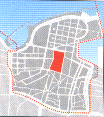
With the beginning of spring, SOLIDERE launched the reconstruction of the traditional Souks of Beirut after finalizing permit procedures from the Municipality for the construction of underground parking facilities for 2,500 cars.

SOLIDERE has received bids from Lebanese and international contractors to build the underground parking as a result of a tender announced in February. The Company is in the process of evaluating the bids to choose the best among them and to begin construction. Following the completion of excavation works, construction is scheduled to begin this year.
Meanwhile, detailed studies of the Souks architecture will be finalized in 1997. This will enable SOLIDERE to proceed with construction of the Souks as soon as the four-story underground parking is completed.
The traditional souks of Beirut-Tawileh, Ayyas, and Al Jamil- were located in the geographic center of the BCD, west of the Foch-Allenby area. One of their main entrances is at the crossing of Riad el Solh street (also known as Banking Street) and Weygand, which is close to the commercial area of Foch-Allenby, the Port and the Hotel District. The new Souks, constructed on the same site will form a link between the traditional center and the reclaimed area.
The reconstruction of the traditional Souks over a land area of 60,000 square meters will provide about 100,000 square meters of floor space distributed as follow: 50,000 m2 for retail outlets, 15,000 m2 for entertainment, 30,000 m2 for offices, and 5,000 m2 of residential space, in addition to a central park and attractive green areas.
The entertainment area will house a cinema complex with nine movie theaters equipped with the most modern technical facilities, among the movie theater 1-Max, offering three dimensional (3D) screens. It will be the first theater of its kind in the Middle East. Areas will be dedicated for video and virtual reality games and a variety of restaurants, providing shoppers and visitors with an easily accessible stop.
Award-winning architects are designing the new Souks. Nabil Tabbarrah, Samir Khairallah and Partners in cooperation with Rafael Moneo of Spain, Rafik Khoury in cooperation with the British architect Kevin Dash, Anabelle Karim Kassar in cooperation with the French firm of Vallode et Pistre, in addition to the Lebanese-Belgium Tractabel office which is in charge of the construction and electro- mechanical engineering designs, and of the follow-up and construction supervision.
The responsibility for coordination and standardization among these designs is assigned to the French expert in the field of marketing construction, Olivier Vidal, who has also been given the responsibility for the landscape of public gardens.
All of the architects operate within the guidelines of a Souks master plan designed by Jad Tabet in cooperation with Samir Khairallah as a result of international ideas competition held for that purpose.
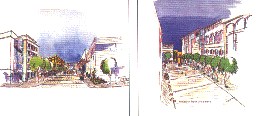
Among the most important characteristics of this master plan is the emphasis it places on the preservation, as much as possible, of the previous urban grid of the Souks, which have remained practically unchanged throughout the centuries, as shown by recent archeological excavations.
The process of integrating some of the discovered archeological landmarks in this site with the buildings and public spaces, will give the Souks of Beirut a historical character and identity that will distinguish it from other commercial centers in the entire region.
In line with an understanding with the Ministry of Culture and Higher Education, a study will be conducted to look into the possibility of integrating the Phoenician quarter uncovered in this area- and which dates back to the Persian period- into the new Souks. One of the important characteristics of this quarter is the fact that it provides evidence of the site's history as a trading post dating back 5,000 years.
SOLIDERE is finalizing agreements on rent and lease for all of the major Souks anchors that include the entertainment complex, the movie theaters, a supermarket, department store, and the jewelry markets. marketing of the small and medium sized retail outlets will follow.
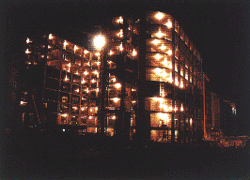
Infrastructure works reached an advanced stage in the beginning of 1997, with about 85% of works finalized in the Nejmeh square. In the areas of Saifi, Bashoura and Foch-Allenby, they are virtually completed. Works have now started in the areas around Army Street in Zoukak el Blat, and continue to advance in the area of Minet el Hosn.
In Gouraud, Weygand, and Riad el Solh work on a walk through culvert is being finalized. Also, construction of the support walls in Emir Bashir Street has been completed, and works are underway on the construction of support walls in Army Street. Work on the George Haddad underpass has been also completed, while the construction of Mar Elias tunnel, connecting Fouad Chehab Avenue with the end of the Fakherddine Street facing the Phoenicia Hotel continues.
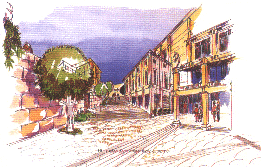
The concrete structure for the building on Riad el Solh square that will house regional United Nations offices, including the headquarters of Economic and Social Commission for West Asia (ESCWA) is complete. Currently, preparations are underway to construct the iron bridge that will connect the two sides of the building at the level of the eighth floor above the garden in the interior court of the building. Work on the glass, aluminum and granite facade of the building will start soon, at a pace of eight glass units a day. work on the interior walls have commenced on the first six floors, as has the installation of mechanical and electrical equipment.
Infrastructure works in the vicinity are also underway so that the building and the area will be ready for occupancy toward the end of 1997. Work is on fast track, night and day.
Location |
Building type and use |
Number of Bldg. |
Built-up space m2 |
Commentary |
| Marfaa Rehabilitation
Foch-Allenby |
Rehabilitation
as office bldgs |
11 | 17,400 | 3 bldgs restored occupied in 1996; occupied in 1996; 5 will be completed in 1997 |
| Marfaa
Nejmeh-Maarad |
Rehabilitation as office bldgs | 8 | 16,300 | To be delivered in 1997, 1998 |
| Bashoura
Emir Bashir Str |
Grand Theatre
Information Center Entertainment and Office Builds |
3 | 22,200 | Delivery expected for 1999 |
| Bashoura
Riad el Solh |
New Building | 1 | 21,400 | To be delivered in 1997, leased United Nations agencies |
Minet el Hosn Wadi Abou Jamil
|
Restored bldgs
residential, commercial |
12 | 16,800 | To be delivered in 1998, 1999 |
| Zokak el Blat
|
Restored bldgs residential, commercial | 19 | 19,400 | To be delivered in 1998, 1999 |
| Marfaa
Souks of Beirut
|
New bldgs, underground parkings, entertainment, residential, commercial space | 25 | 58,000 | To be delivered in 1999 |
| Saifi, refurbishing | Refurbishing residential, commercial | 12 | 14,300 | To be delivered in 1998, 1999 |
| Saifi, new residential units | new bldgs, residential, commercial | 17 | 35,000 | To be delivered in 1999 |
| Zokak el Blat Administrative offices | Newly refurbished bldgs | 7 | 17,900 | To be delivered in 1999, to be used as government offices |
| Zokak el Blat Administrative offices | Newly refurbished bldgs | 2 | 41,000 | To be delivered in 1999, to be used as government offices |
Total -------------------------------------------------------------------------------- 280,500
One of SOLIDERE'S major strategic decisions has been to rehabilitate retained buildings and develop new projects to offer them on the rental market. SOLIDERE is expected to rent or lease more than 250,000 square meters of floor space by end 1999, distributed over 100 buildings, all of them in distinctive locations in the BCD. Contracts have already been signed committing half of this area for lease.
SOLIDERE adopted this marketing strategy following an appraisal of the current situation of the Beirut real estate market and its possible development in the years ahead.
The approach is also the result of a financial strategy to improve the assets of the company and to increase the value of its reconstruction project.
SOLIDERE'S marketing strategy seeks to increase the value of the real estate in the BCD in the most conclusive and expeditious way, allowing the city center to recapture, as soon as possible, its importance as a privileged location. To ensure the success of this strategy, SOLIDERE will play an active role as the lead developer in the BCD. It is essential that the real estate market in the city center offer a diversified range of opportunities, as important one among them being rental and leasing options.
SOLIDER's strategic investment in the rental market will guarantee that the BCD enjoys a flexible diversity of offerings and that the company is able to maximize revenue from its assets. As the proprietor of large housing, office and commercial space, SOLIDERE is able to adopt a comprehensive strategy in improving and diversifying its offer in the rich mixed-use environment of the BCD.
Financially, the decision to create a rental market in the BCD benefits SOLIDERE in a variety of ways. Real estate development and marketing are long term activities and regulating their exact returns is a complicated and difficult task. However, leases and rents provide regular and steady sources of income, allowing SOLIDERE to maintain a more informed forecast of its revenues and dividends. this is particularly important as Company shares are traded in the bourse.
Through its emphasis on high standards and its ability to oversee the development and reconstruction of the city center, SOLIDERE can optimize the value of its real estates assets as each building profits from the comprehensive development and marketing approach. SOLIDERE's real estates assets also allow it to adopt a flexible financial strategy, so that it can, in the appropriate time, resort to real estate operations, sales and purchases, or to mobilize its financial capabilities on the basis of its rental properties.
Over the years, the creation of a rental market will prove beneficial of the company on a number of levels, and will increase the value of its real estate assets considerably.
SOLIDERE is continuing reclamation works in the Normandy area where land gained on the sea now covers about 400,000 square meters. The final land area is to be 608,000 m2, as designated in the BCD master plan.
Concurrently, work started on January 15, 1997 on the sea defense lines for the new waterfront. The first phase, which will last eight months, involves detailed studies, the development of hydraulic models and laboratory tests.
It will be followed by the implementation of the project which is to last 38 months.
SOLIDERE has issued tender documents approved by the Directorate General of Urban Planning which involve specifications for all restoration works to be carried out on all retained buildings in the BCD. The company is monitoring these works to ensure the application of the required specifications, including stone facades, doors, windows, outside balconies, in addition to the installation of fire safety systems, and facilities for the physically handicapped.
There are 11 kinds of stones used on the facades of preserved BCD buildings, some are yellow, others have a sandy color. Most of them originate from local quarries in different regions of Lebanon. Currently, most of the artisans working on restoration are from Mount Lebanon and a few are from Aleppo in Syria.
The process of restoration starts with a hot-jet stream washing of the facades. When required, special chemicals are also used. Following the cleaning process, samples of the stones are examined to allow restorers to identify them and procure replacements for damaged sections. When a replacement is found, SOLIDERE will test the new sample to see if they will respond to the effects of wear and pollution in similar ways, to ensure that irregularities do not disfigure the facades in later years. If the results are acceptable, the contractor can proceed with the purchase of the new stone. The implementation phase of restoration is then launched, requiring attentive care by the contractor and continuous monitoring by SOLIDERE to make sure that restoration complies with stipulated methods and specifications.
Building parts damaged by war are removed and replaced by similar pieces, and stone curving are carefully replicated. In accordance with directives from the Directorate General of Urban Planning, the old stones facades must be maintained as they were.
Doors and windows have to be duplicated in exactly the same design. If they have been stolen or destroyed by war or fire, as is very often the case, then pictures of the buildings must be obtained from private sources or books on Beirut's architecture to allow for their duplication. If such information is not available, then the architect will be asked to submit suitable designs that are in line with the designs of the building. A sample is then prepared for evaluation and approval by SOLIDERE. The same procedures applies for other materials to be used in the restoration process, such as wood, door and window panels. wrought iron balconies and the finishing of exterior facades.
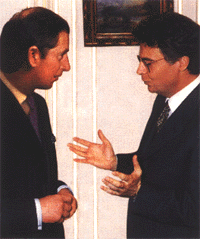
HRH the Prince of Wales says he is impressed with the pace of reconstruction in the BCD and, in a conversation with Chairman Nasser Chammaa, has lauded the Solidere model and approach toward the revitalization of the city center. Speaking at a London reception organized to launch the Prince of Wales Institute "Urban Task Force for Lebanon", Prince Charles said he hoped to have a chance to visit Lebanon soon.
Urban planners and students from around the world will take part in a 3-week workshop in Sidon and in an "Action Planning Week" in Beirut centered around the green line and areas adjacent to the BCD. Both Task Force projects seek to encourage direct community participation in reconstruction. SOLIDERE is one of the sponsors of the Task Force.
In a statement read at the reception, SOLIDERE's Chairman and General Manager Nasser Chammaa welcomed the interest shown by HRH the Prince of Wales in the reconstruction of Lebanon. "We are interested in impacting positively on adjacent areas, said Chammaa, "and the support and involvement of the community is essential for the success of any reconstruction program".
SOLIDERE participated in the international real estate fair MIPIM held in Cannes in March 1997, probably the largest event of its kind in the world. This year, MIPIM attracted about 2,000 exhibitors, representing projects from 50 countries.
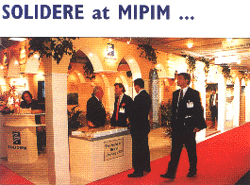
Nearly 7,500 international experts in real estate marketing and investment attended the event. Fifty European mayors visited this exhibition, most of them making a stop at SOLIDERE stand where they could see a model of the project and hear a presentation. A brochure specially designed for the occasion was distributed to thousands of visitors.
A Brazilian delegation headed by foreign minister Luis Felipe Lambreia visited the BCD and Solidere headquarters last quarter, one of many official delegations to be briefed on ongoing works. Other visitors included an Austrian delegation headed by minister of foreign affairs Benita Ferrero Valdner, a Cypriot delegation headed by minister of justice Alecos Evanelou, the chief of foreign relations office in the Japanese prime Minister's Office Hiroshi Hirabayashi, and president of the Geneva Parliament, Christine Sayegh. Among other visitors were also the Australian ambassador in Amman, Merry Wicks, and in Riyadh, Philip Knight, and other international public officials, in addition to journalists, archeological experts and local dignitaries and delegations.
SOLIDERE also participated in a meeting of the International Federation of Mayors of Francophone Cities held in Marrakech in Morocco in early March 1997. during the conference, the Deputy General Manager of SOLIDERE Jean Paul Lebas read a paper on the "Reconstruction of the heritage of the Center of Beirut". Lebas recounted how the preservation of the heritage of the BCD developed into one of the main objectives of the master plan, and the different legal and financial avenues used to meet these objectives.
1996-97 Copyright Lebanon.com Interactive.